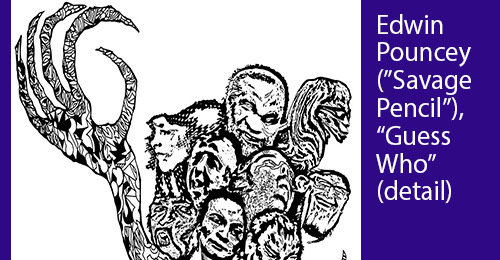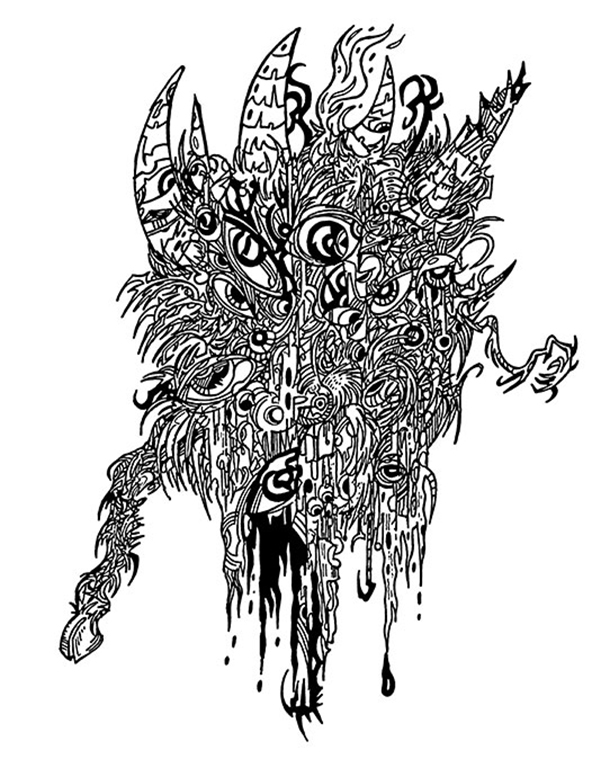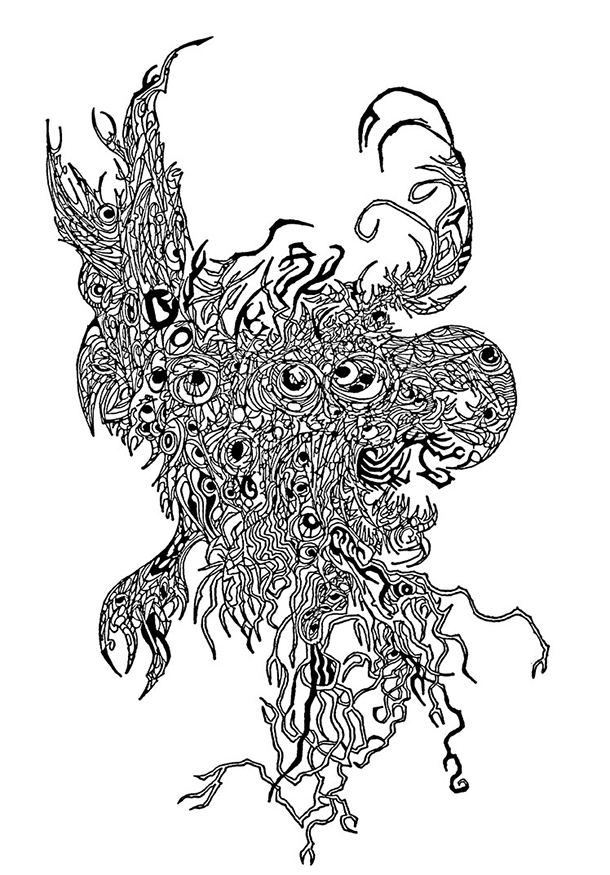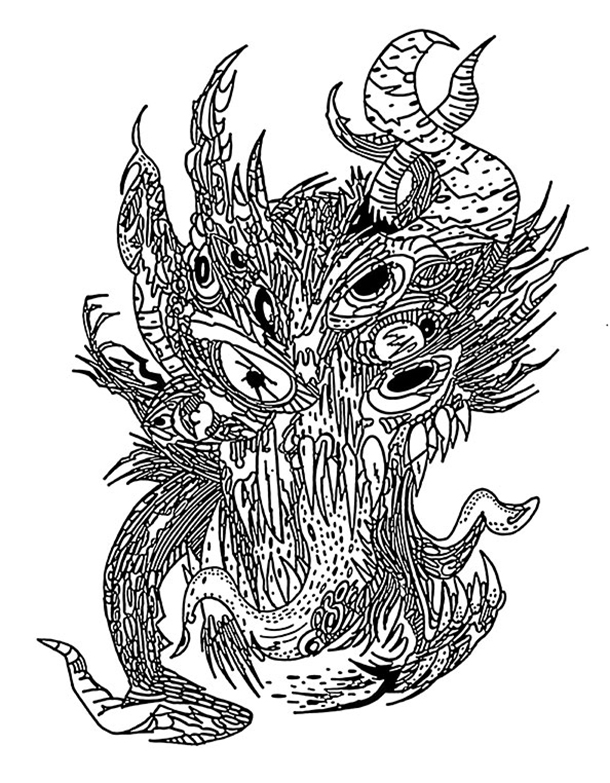
INSPIRED BY A SEATTLE-BASED DRONE-METAL BAND, AN UNDERGROUND COMIX ARTIST’S DRAWINGS DEPICT MUSIC-SOAKED “DEMONS”
In addition to her look at the Atlantis Bookshop, one of London’s oldest specialty-retail outlets, focusing on magic, esoterica, and the occult (see the separate article in this issue), brutjournal’s artist-correspondent in the British capital, Cathy Ward, brings us this report about the artist whose exhibition is now on view in the store’s gallery space.
Savage Pencil: DEMO)))NS FOR SUNN O)))
Exhibition at the Atlantis Bookshop
49a Museum Street
Bloomsbury
London WC1A 1LY United Kingdom
On view from June 1 through July 2, 2022
Telephone: (44) 020 7405 2120
Cathy Ward reports:
LONDON — The creativity of the British artist Edwin Pouncey, who is also known, as an underground cartoonist, as “Savage Pencil,” spans the fields of art, literature, and music; he is also very knowledgeable about the occult, which makes the Atlantis Bookshop a most appropriate venue for this current presentation of his recent work.
Pouncey has an insider’s knowledge of the many bands whose records and performances he has reviewed over several decades for such British music magazines as New Musical Express, Sounds, and the Wire.

His graphic work may be seen as a form of delightful, acerbic gossip about the musical heroes of our time. Pouncey has written about or has long been steeped in the music of such legendary performers as Frank Zappa, the Grateful Dead, Mikey Dread, the Fall, Black Uhuru, Crass, the Cult, Lou Reed, Burning Spear, King Sunny Ade, Afrika Bambaataa, Grandmaster Flash & the Furious Five, Captain Beefheart and His Magic Band, the Gun Club, Linton Kwesi Johnson, Destroy All Monsters, John Sinclair, MC5, Iggy Pop & the Stooges, Anthrax, Tom Waits, Sonic Youth, Neil Young, Suicide, Alan Vega, Hüsker Dü, Swans, R.E.M., Henry Rollins, Nirvana, the Pixies, Mazzy Star, Robert Plant, Jimmy Page, Dinosaur Jr., Mötley Crüe, Jimi Hendrix, Coil, Radiohead, Earth, and Sunn O))).
His non-commercial work feels intuitive and intense as it appears to draw upon the artist’s inner demons in a maelstrom of unbridled energy. Savage Pencil has frequently shown his art at the Horse Hospital, London’s premier underground arts venue, where he has also collaborated on various projects and events with such fellow creatives as the British comic-book writer Alan Moore and Cary Loren of the Detroit psychedelic/punk/noise/performance-art band Destroy All Monsters (whose members also included Mike Kelley, Jim Shaw, and Niagara (Lynn Rovner)).

Pouncey/Savage Pencil has also collaborated and exhibited his work with Loren in Kelley’s “Mobile Homestead,” a permanent installation at the Museum of Contemporary Art, Detroit, consisting of a full-scale replica of the 1950s-era, ranch-style house in Detroit in which Kelley grew up. Pouncey has also shown his work at Ecstatic Peace Library, a record shop and gallery opened in East London in 2020 by the Sonic Youth guitarist Thurston Moore.

As noted in my separate article in this issue of brutjournal, as it commemorates the 100th anniversary its founding, this year, the Atlantis Bookshop, which specializes in magic, esoterica, and the occult, will be presenting an ongoing program of celebratory events, of which the current Savage Pencil exhibition is one.
Pouncey’s presentation features material he produced under the influence of the music of Sunn O))), an American band from Seattle that is known for its doom metal/drone/dark ambient/noise-rock sound. Greg Anderson and Stephen O’Malley founded the band in 1998, partly in homage to the guitarist Dylan Carlson’s avant-garde, minimalistic, drone-metal band, Earth.
Recently, I caught up with Pouncey via e-mail, and asked him, for starters, “What’s with your fascination with Sunn O)))?”
Pouncey replied: “I was first introduced to the music of Sunn O))) by the artist-musician Russell Haswell, who, like me, was a fan of noise and black metal. He insisted that I go down to HMV [, the record store] in Oxford Street that is now some corporate sports shop, and pick up a copy of Sunn O)))’s ØØ VOID, their debut recording from 2000, which had just been released. I did as I was told, took said CD home, and cranked it all the way up. The room shuddered, and it felt good.”

For Pouncey, what he heard was “metal music that had been stripped down to a basic, primal drone, but one that was seething with hidden detail and a spiritual vibration that was more attuned to late John Coltrane and La Monte Young than Black Sabbath or Mayhem.”
He observed, “The dark shadows of hard rock and black metal were obviously a key factor in the music Stephen and Greg were involved with, as was, I later learned, bagpipe music, as it was that instrument that Stephen had learned to play in his high school band. The roots of their drone sound go deep.”
Pouncey explained that, with that first Sunn O))) album, he was “hooked.” He recalled, “The feeling I got when first hearing their sound was the equivalent of my first aural encounter with Sonic Youth. They made me want to somehow get involved with their creation. It wasn’t enough to simply appreciate what they were doing; I wanted to be a part of their action.”
At some point, the artist reached out to the American band. He said, “Luckily for me, they liked my stuff, too, and asked me to come up with a poster design for a gig they were booked to play at London’s Underworld, in Camden. After that, they asked me to supply a suitable demon [image] for each of their U.K. shows, including the duo performance they will be playing [later this month,] on June 22, at Fabric. It’s this collection of demon drawings and art that forms my latest exhibition at Atlantis Bookshop, Savage Pencil’s DEMO)))NS FOR SUNN O))).”
[Editor’s note: Fabric is a nightclub in central London’s Farringdon district.]
I asked Pouncey if he has developed a close relationship withSunn O)))’s founders,Greg Anderson and Stephen O’Malley, and if there is a particular era of the band’s music that especially resonates with him.
He said,“That early show at Underworld [, an alternative-rock club in London,] was massively important, but so was their pre-COVID Roundhouse show in 2019 [in support of their album] Life Metal. I also affectionately remember the [earlier shows in support of their album] Kannon at the Royal Festival Hall at the Southbank Centre [in August 2015], especially the one in which they played so loudly they dislodged part of an old lighting rig, and it came crashing down. No bones were broken, thankfully, but that was fun.”
How have Pouncey’s collecting activities and other interests influenced his creative output?
The artist said, “My interest in underground comix began when I read ‘Smut For Love, Art, Society,’ by David Zack, an article in a 1969 issue of Art and Artists magazine. Zack’s subject matter, together with the comix panels he had chosen to illustrate his piece, impressed me so much that I decided there and then that I was going to be an underground comix artist. I was 18 years old at the time.”

“Since then, I have followed my own path of discovery. My interest in the occult revolves mainly around the work of the Edwardian artist and magician Austin Osman Spare [1886-1956], whose subconscious working method, together with his own system of magic, I have attempted to develop in my own way. This combination of comix and occult art has evolved into a style I can truly recognize as my own.”
Pouncey said that he continues to develop his distinctive style, and that “it keeps changing shape, while still retaining the roots” of his original art-making efforts. He noted that music has always played a big role in his work.
In the black-and-white drawings he is now showing at the Atlantis Bookshop, sometimes slightly abstracted animal heads appear. In one, a pack of human heads appears to grow out of a crab-like body, whose long arm extends up and features a big, claw-like hand.

The artist told me, “I’ve always been interested in music and collecting records, the bulk of which are rock- or metal-related. I also have a large collection of free-jazz, black-metal, and noise LPs. Listening to them while drawing allows me to think beyond the lines I’m putting down on the paper until a kind of trance state is reached. Sometimes I can do this without music, but noise can be a useful guide and add a certain creative pulse to the drawing I’m working on.”
Among other projects, Pouncey is overseeing an issue of Ambit Pop, the new, guest-edited version of Ambit, a British magazine of art, prose, poetry, and reviews that is now edited by Kirsty Allison, whose debut novel, Psychomachia (Wrecking Ball Press), was published last year.
Pouncey said, “It has been an amazing opportunity and I’m thrilled with the end result. I’m proud to be associated with Ambit, a literary and arts journal that has been published since 1959 and has published work by J.G. Ballard, Eduardo Paolozzi, and William S Burroughs. I was thrilled by the quality of the work I received from the invited contributors to this latest issue (Ambit Pop 247), and the opportunity to interview [my] psychedelic art hero, Stanley Mouse, was one I couldn’t pass up.”

Of course, Pouncey’s association with the Atlantis Bookshop was something I asked him to describe. Noting that this year marks the store’s 100th anniversary, he said, “As part of their celebration, I thought it might be good to do another show there. I prefer showing my work in bookshops and record shops, mainly because all that white gallery space [of typical contemporary-art galleries] is kind of intimidating and, unless I know the people involved, I feel as though I’m not really making contact.”
“The Atlantis Bookshop is a kind of spiritual home to me, with a clientele that runs from [the British occultist and ceremonial magician] Aleister Crowley through to [Led Zeppelin guitarist] Jimmy Page, and its, owners Geraldine and Bali Beskin, are very sympathetic and tuned in to the work I’m producing. We all support each other spiritually and creatively — and that’s something precious and beautiful.”



